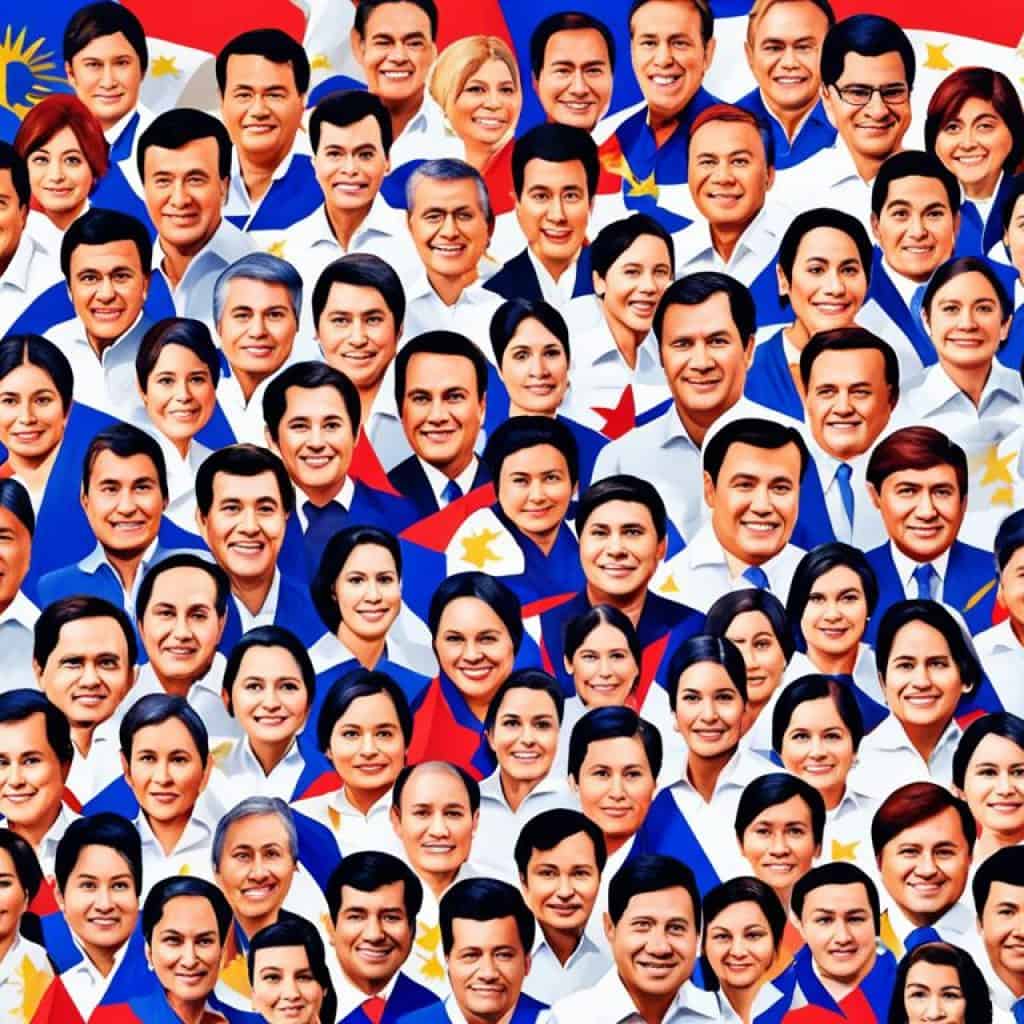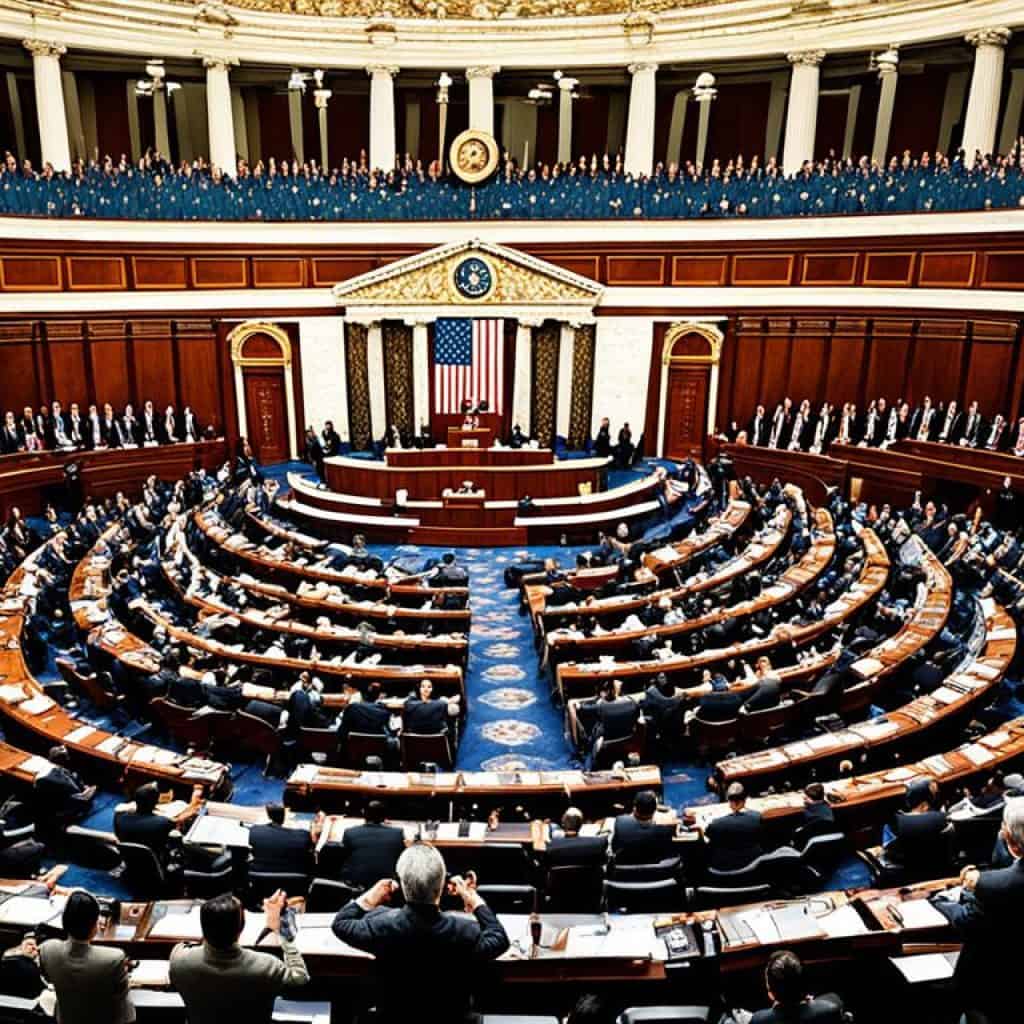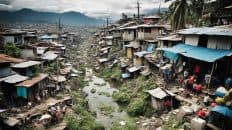Do you know who holds the position of power and influence in the Senate of the Philippines? Are you curious to see who are the 24 Senators shaping the country’s laws and policies in 2024?
In this article, we will introduce you to the current roster of Senators in the Philippines. Get ready to discover the individuals who play a vital role in governance, legislation, and the progress of the nation.
Key Takeaways:
- Discover the 24 Senators who hold influential positions in the Senate of the Philippines in 2024.
- Learn about their roles and responsibilities in shaping the country’s laws and policies.
- Gain insights into the diversity of political parties and regions represented by the Senators.
- Find out about the Senate session and term structure, and how it impacts continuity and experience within the Senate.
- Understand the significance of the Senate and the House of Representatives in the Philippine legislative system and governance.
About the Senate of the Philippines
The Senate of the Philippines is the upper house of the Congress of the Philippines. It is the legislative body responsible for passing laws and representing the interests of the Filipino people. The Senate is composed of 24 senators who are elected at-large under a plurality-at-large voting system.
Role and Responsibilities
- Passing laws: The Senate plays a crucial role in the lawmaking process. Senators propose, debate, and vote on bills that address various issues affecting the country.
- Representing the people: Senators are elected by the Filipino people and are tasked with representing their interests. They serve as the voice of the nation and work to address the concerns and needs of their constituents.
- Check and balance: The Senate serves as a check on the executive branch and ensures that policies and actions of the government remain in line with the interests of the people. Senators have the power to investigate, impeach, and make decisions on matters of national importance.
“The Senate of the Philippines is an essential pillar of democracy, providing a platform for meaningful debates and discussions that shape the country’s future.”
Plurality-at-Large Voting System
The election of senators in the Philippines follows a plurality-at-large voting system. This means that the 24 senatorial seats are contested on a nationwide basis, and voters are allowed to choose up to 12 candidates. The 12 candidates who receive the most votes are declared the winners and become senators.
Representation and Diversity
The Senate aims to provide representation and diversity by ensuring that senators come from different regions and sectors of the country. This allows for a broader perspective and the inclusion of various interests in the legislative process. Senators are often affiliated with different political parties, adding to the diversity of ideas and viewpoints within the Senate.
Senate Leadership
The Senate of the Philippines is led by a team of dedicated individuals who hold key positions to ensure the smooth functioning of the legislative body. These leaders play vital roles in guiding the Senate’s agenda and managing its affairs. Let’s meet the current Senate leaders:
Senate President: Migz Zubiri
Migz Zubiri serves as the Senate President, the highest-ranking official in the Senate. As the Senate President, he presides over the sessions, maintains order, and represents the Senate in its external relations. His leadership is crucial in steering the Senate towards achieving its legislative goals.
Senate President pro tempore: Loren Legarda
Loren Legarda holds the position of Senate President pro tempore, making her the second-highest-ranking official in the Senate. In the absence of the Senate President, she assumes the role and responsibilities of the Senate President. Loren Legarda plays a pivotal role in ensuring the smooth functioning of the Senate.
Majority Leader: Joel Villanueva
Joel Villanueva serves as the Majority Leader of the Senate. The Majority Leader plays a significant role in shaping the Senate’s legislative agenda, coordinating with fellow senators, and facilitating the passage of bills. Joel Villanueva’s leadership skills and expertise contribute to the efficient operation of the Senate.
Minority Leader: Koko Pimentel
Koko Pimentel is the Minority Leader of the Senate. As the leader of the minority bloc, he represents the interests and viewpoints of the minority senators. The Minority Leader plays a crucial role in ensuring a balanced and diverse legislative process, fostering healthy debates, and articulating the concerns of the minority.
These Senate leaders, including Senate President Migz Zubiri, Senate President pro tempore Loren Legarda, Majority Leader Joel Villanueva, and Minority Leader Koko Pimentel, collectively contribute to the effective governance and legislation in the Philippines. Their dedication and expertise guide the Senate towards delivering impactful policies and representing the best interests of the Filipino people.
Composition of the Senate
The Senate of the Philippines is composed of 24 senators who are elected at-large by the qualified voters of the country. These senators come from different political parties and represent various regions and sectors of the Philippines. They play a crucial role in the legislative process, voicing the concerns and advocating for the interests of their constituents.
Let’s take a closer look at some of the notable names among the 2024 batch of senators:
These senators are dedicated to serving the Filipino people, working towards the betterment of the country and its citizens. They bring diverse perspectives and expertise to the Senate, contributing to the formation of comprehensive and effective policies.

Senate Sessions and Terms
Senators in the Philippines serve six-year terms, with a maximum of two consecutive terms. The length of their term is determined by Article VI of the Constitution of the Philippines.
The Senate conducts regular sessions and special sessions, each lasting for a specific period of time. Regular sessions are held on specific dates outlined by law, while special sessions may be called by the President or requested by the majority of the senators.
“Regular sessions shall begin on the fourth Monday of July and shall end on the thirty days before the start of the next regular session. Special sessions may be called at any time by the President or upon the request of the majority of the members of both Houses.”
The regular session period allows senators to fulfill their legislative duties, participate in committee meetings, and debate and pass bills. Special sessions, on the other hand, are called for specific purposes or urgent matters that require immediate attention.
During the sessions, senators engage in deliberations, debates, and voting on proposed legislation. They collaborate with their peers to analyze, amend, and improve bills, ensuring that they address the needs and concerns of the Filipino people.
Senate sessions play a crucial role in shaping the laws and policies of the country, as they provide a platform for open discourse, collaboration, and democratic decision-making.
The following table provides an overview of the Senate sessions and terms:
| Session Type | Duration |
|---|---|
| Regular Session | From the fourth Monday of July to thirty days before the start of the next regular session |
| Special Session | Called by the President or upon request of the majority of members from both Houses |
Senate Leadership Structure
The Senate of the Philippines operates with a well-defined leadership structure that ensures the smooth functioning of the legislative body. Let’s take a closer look at the key leadership positions within the Senate, including the Senate President, Senate President pro tempore, Majority Floor Leader, and Minority Floor Leader.
Senate President: As the presiding officer and highest-ranking official of the Senate, the Senate President holds a critical role in guiding the deliberations and decision-making processes. Currently, the Senate President is Migz Zubiri, who leads the Senate with distinction and expertise.
Senate President pro tempore: The second-highest-ranking official in the Senate, the Senate President pro tempore assumes the responsibilities of the Senate President in their absence. This position ensures continuity and ensures the Senate operates smoothly even when the Senate President is unavailable. Loren Legarda currently serves as the Senate President pro tempore, providing valuable support to the Senate President.
Majority Floor Leader: Responsible for managing the legislative agenda of the majority bloc within the Senate, the Majority Floor Leader plays a crucial role in coordinating and advancing the majority’s priorities. Currently, Joel Villanueva serves as the Majority Floor Leader, contributing to the efficient operation of the Senate.
Minority Floor Leader: Representing the minority bloc within the Senate, the Minority Floor Leader serves as the voice of the minority members and ensures their perspectives are heard. Koko Pimentel is the current Minority Floor Leader, advocating for the interests of the minority bloc in the Senate.
“The Senate leadership structure reflects the commitment to inclusivity and effective governance. With the Senate President, Senate President pro tempore, Majority Floor Leader, and Minority Floor Leader working together, the Senate can fulfill its mandate to serve the Filipino people.”
This structured hierarchy within the Senate provides a clear framework for decision-making, agenda setting, and representation within the legislative process. The collaboration and coordination among the Senate leaders contribute to the efficient operation of the Senate and the pursuit of the nation’s best interests.
Senate Leadership Structure at a Glance:
| Position | Name |
|---|---|
| Senate President | Migz Zubiri |
| Senate President pro tempore | Loren Legarda |
| Majority Floor Leader | Joel Villanueva |
| Minority Floor Leader | Koko Pimentel |
House of Representatives
The House of Representatives is an integral part of the Congress of the Philippines, serving as the lower house. It is composed of representatives who are elected from various legislative districts and party-list organizations. These representatives act as the voice of their constituents, advocating for their interests and concerns.
The House Speaker holds the highest-ranking position within the House of Representatives and plays a crucial role in leading its proceedings. The House Speaker is responsible for managing debates, facilitating legislative discussions, and guiding the legislative agenda. As a key figure in the House, the House Speaker has the authority to influence the direction and outcome of legislation.

The House of Representatives operates under a structure where representatives from different districts and party-list organizations come together to discuss and deliberate on various legislative matters. Through their collective efforts, the members of the House of Representatives aim to uphold the welfare and interests of the Filipino people.
The 19th Congress of the Philippines
The 19th Congress of the Philippines, which commenced on July 25, 2022, and will conclude on June 6, 2025, serves as the legislative body during the first three years of Bongbong Marcos’s presidency. Formed after the 2022 general elections, this Congress marks a significant period of governance and policymaking in the Philippines.
As the legislative authority representing the Filipino people, the 19th Congress holds the responsibility of enacting laws and regulations that shape the nation’s future. With Bongbong Marcos at the helm, this Congress aims to deliver progressive and impactful initiatives to drive economic growth, enhance social welfare, and foster national unity.
The 19th Congress is comprised of a new composition of both the Senate and the House of Representatives, with elected members from various political parties and sectors representing the diverse interests of the Filipino population. Through collaborative efforts, this Congress strives to bridge differences, prioritize the welfare of the people, and address pressing national concerns.
“The 19th Congress of the Philippines represents a new era of governance and leadership, dedicated to fulfilling the aspirations of the Filipino people and advancing the nation’s interests. Through effective legislation and open dialogue, we aim to create a more prosperous and inclusive future for all.”During the tenure of the 19th Congress, legislative priorities span a broad spectrum of issues, including economic reform, infrastructure development, healthcare, education, environmental sustainability, and social justice. The collective efforts of senators and representatives will contribute to shaping policies that address the needs of the citizens and propel the Philippines towards progress.
The journey of the 19th Congress is marked by the pursuit of transparency, accountability, and effective governance. Embracing the principles of democracy, this legislative body provides a platform for open debates, constructive discussions, and evidence-based decision-making. The dedication of its members in upholding the rule of law will foster a stronger, more resilient nation.
Vision for the Future
The 19th Congress seeks to carve a path towards a brighter future for the Philippines, guided by a bold vision and driven by the determination to build a nation that remains steadfast in the face of challenges. By fostering collaboration between the executive and legislative branches, this Congress aims to implement reforms, promote social justice, strengthen institutions, and ensure equitable development throughout the country.
Key Objectives Actions Economic Growth Implement policies to attract investments, stimulate job creation, and support the growth of key industries. Social Welfare Enhance programs and services that address poverty, provide healthcare accessibility, and promote sustainable livelihoods. Infrastructure Development Prioritize strategic infrastructure projects to enhance connectivity, mobility, and regional development. Environmental Sustainability Advocate for sustainable practices, conserving natural resources, and mitigating the impacts of climate change. Social Justice Pass legislations to protect human rights, uphold the rule of law, and ensure equality and inclusivity for all Filipinos. The 19th Congress of the Philippines is an embodiment of the Filipino people’s aspirations for progress, unity, and a better future. By collectively working towards national development, this Congress aims to leave a lasting legacy that will positively impact generations to come.
Senate and House Leadership
In the Philippine legislative system, both the Senate and the House of Representatives have their own set of leaders who play vital roles in the smooth functioning of their respective chambers.
The Senate is headed by the Senate President, while the House of Representatives is led by the Speaker of the House.
The Senate President is responsible for setting the legislative agenda in the Senate. This position holds significant influence and is crucial in guiding the Senate’s deliberations and decision-making processes.
“The Senate President’s leadership is critical in ensuring that the Senate effectively carries out its legislative functions and serves the best interests of the Filipino people.”
The Speaker of the House, on the other hand, assumes a similar role in the House of Representatives. As the highest-ranking official, the Speaker is responsible for presiding over sessions, leading debates, and maintaining order within the House.
The Speaker of the House also plays a crucial role in setting the legislative agenda and ensuring productive discussions among the representatives.
Both the Senate President and the Speaker of the House are elected by their respective chambers and are entrusted with the responsibility to uphold the principles of democracy, represent the interests of their constituents, and facilitate the legislative process.
Under the leadership of the Senate President and the Speaker of the House, the Senate and the House of Representatives work together to enact meaningful legislation, address national issues, and shape the future of the Philippines.
Senate Terms and Membership
The composition of the Senate is an integral part of the Philippine legislative system. It is comprised of 24 members, each serving a six-year term, ensuring continuity and stability in governance. The Senate membership is staggered, with half of the senators being elected every three years. This allows for the infusion of fresh perspectives and ideas while maintaining a balance of experienced legislators within the Senate.
The concept of staggered terms emphasizes the importance of experience, expertise, and institutional knowledge in the legislative process. It enables senators to gain a deeper understanding of the issues at hand, foster relationships with colleagues, and effectively navigate the complexities of lawmaking.
The Senate terms also serve as an opportunity for senators to establish themselves as leaders and champions for the causes they represent. It allows them to deepen their engagement with the Filipino people, creating a space for public service, and fostering meaningful connections with communities.
“The Senate terms and staggered membership structure are designed to ensure that our legislators have the necessary time and resources to effect meaningful change and represent the interests of the Filipino people.” – Senator [Last Name]
Through their dedicated service and commitment to the welfare of the nation, senators strive to leave a lasting impact and contribute to the progress and development of the Philippines.

District Representatives
In the House of Representatives, district representatives are elected by the voters within their respective legislative districts. These representatives serve as the voice of their constituents and play a crucial role in the legislative process. Just like senators in the upper house, district representatives are responsible for representing and advocating for the interests and welfare of the people they represent.
Responsibilities of District Representatives
District representatives have the important task of representing the specific geographic area they were elected to serve. This means they must understand the unique needs and concerns of their constituents and work to address them through legislation and policy-making. They actively participate in debates and discussions, vote on bills, and engage in committee work to shape policies that impact their district and the country as a whole.
District representatives are also responsible for communicating with their constituents and keeping them informed about legislative developments and government initiatives. They act as a liaison between the people and the legislative body, ensuring that the voices and concerns of their constituents are heard and considered.
Composition of the House of Representatives
The House of Representatives is composed of district representatives from across the country. The number of representatives is determined by the population of each legislative district, with more populous districts having more representatives. This ensures fair representation and a balance of voices in the legislative process.
Here is a table showcasing the number of district representatives per region in the Philippines:
| Region | Number of District Representatives |
|---|---|
| NCR (National Capital Region) | 17 |
| Cordillera Administrative Region (CAR) | 8 |
| Region I (Ilocos Region) | 25 |
| Region II (Cagayan Valley) | 15 |
| Region III (Central Luzon) | 32 |
| Region IV-A (CALABARZON) | 25 |
| Region IV-B (MIMAROPA) | 20 |
| Region V (Bicol Region) | 29 |
| Region VI (Western Visayas) | 32 |
| Region VII (Central Visayas) | 27 |
| Region VIII (Eastern Visayas) | 24 |
| Region IX (Zamboanga Peninsula) | 15 |
| Region X (Northern Mindanao) | 24 |
| Region XI (Davao Region) | 25 |
| Region XII (SOCCSKSARGEN) | 27 |
| Region XIII (Caraga) | 13 |
| BARMM (Bangsamoro Autonomous Region in Muslim Mindanao) | 67 |
As seen in the table, the number of district representatives varies across different regions, reflecting the varying population sizes and needs of each area.
“District representatives have a unique opportunity to directly impact the lives of their constituents. They are at the forefront of addressing local issues and working towards the betterment of their communities. Their role in the legislative process is essential for effective governance and ensuring the voices of the people are heard.”
Next: Section 12 – House Leadership Structure
House Leadership Structure
The House of Representatives, similar to the Senate, operates with a hierarchical leadership structure. This structure ensures effective management of the House’s affairs and the successful implementation of legislative agendas. At the helm of this structure is the Speaker of the House, the highest-ranking official in the House of Representatives. Alongside the Speaker, two other key positions contribute to the smooth functioning of the House: the Majority Floor Leader and the Minority Floor Leader.
The Speaker of the House assumes significant responsibilities within the legislative process. This esteemed position involves presiding over House sessions, guiding the flow of discussions, and ensuring that debates are conducted according to established rules and procedures. The Speaker also plays a crucial role in determining the legislative agenda and prioritizing bills for consideration. As a representative of the entire House, the Speaker’s impartiality and commitment to serving the best interests of the Filipino people are essential.
The Majority Floor Leader serves as an influential member of the House leadership, representing the majority bloc. This position involves coordinating with the Speaker to facilitate the efficient conduct of legislative activities. The Majority Floor Leader works closely with other members of the majority bloc to develop strategies, build consensus, and mobilize support for legislation. By guiding the majority bloc, the Majority Floor Leader helps set the legislative agenda and ensures that the majority’s priorities are effectively pursued.
The Minority Floor Leader represents the minority bloc in the House of Representatives. This position entails articulating the interests and concerns of the minority party, ensuring their voices are heard during debates and decision-making processes. The Minority Floor Leader collaborates with the Speaker and the Majority Floor Leader, advocating for the minority bloc’s legislative priorities and working towards finding common ground for bipartisan cooperation.
“The House of Representatives relies on a strong and effective leadership structure to fulfill its crucial role in shaping legislation and representing the interests of the people. The Speaker of the House, along with the Majority Floor Leader and Minority Floor Leader, play instrumental roles in fostering a productive and inclusive legislative process.”
Together, these three positions in the House leadership structure work in tandem to ensure the smooth functioning of the House of Representatives. By upholding the principles of transparency, collaboration, and accountability, they strive to deliver effective governance and prioritize the needs of the Filipino people.
House Leadership Structure Overview
| Position | Responsibilities |
|---|---|
| Speaker of the House | Presides over House sessions, guides legislative agenda, and represents the entire House of Representatives. |
| Majority Floor Leader | Facilitates legislative activities, coordinates with the Speaker, and represents the majority bloc. |
| Minority Floor Leader | Represents the minority bloc, ensures their voices are heard, and works towards bipartisan cooperation. |
The image above depicts the Speaker of the House, a pivotal figure in the leadership structure of the House of Representatives.
House Sessions and Terms
The House of Representatives follows a similar session and term structure as the Senate. The terms of the members of the House of Representatives also last for three years, with elections held every three years to replace half of the members.
House Sessions
The House of Representatives holds regular sessions and may also have special sessions when necessary. Regular sessions are scheduled for a specific period of time, during which the members of the House convene to discuss and deliberate on proposed legislation, conduct committee hearings, and perform their legislative duties.
House Terms
Members of the House of Representatives are elected to serve a term of three years. This means that every three years, voters have the opportunity to elect new representatives to the House. The staggered elections help ensure continuity and provide the opportunity for fresh voices and ideas to be introduced into the legislative process.
| House of Representatives | Term |
|---|---|
| First Half | 2022â2025 |
| Second Half | 2025â2028 |
Conclusion
The Senate and the House of Representatives are integral parts of the Philippine legislative system. As representatives of the Filipino people, they have the responsibility of passing laws and shaping the nation’s policies. With 24 senators and district representatives at the helm, they ensure the voices of their constituents are heard and their needs are addressed.
These lawmakers play crucial roles in governance and legislation, serving as the bridge between their constituents and the government. Their collective efforts strive to serve the best interests of the people they represent, contributing to the development and progress of the Philippines as a whole.
By upholding the principles of democracy and working towards the betterment of the nation, the Senate and the House of Representatives ensure that the Filipino people have a say in the decision-making process. Together, they uphold the values of transparency, accountability, and public service, fostering an environment where the interests of the people are at the forefront.
FAQ
Who are the 24 Senators of the Philippines in 2024?
The 24 Senators of the Philippines in 2024 include Sonny Angara, Nancy Binay, Pia Cayetano, and Bong Go, among others.
What is the Senate of the Philippines?
The Senate of the Philippines is the upper house of Congress and is responsible for passing laws and representing the interests of the Filipino people.
Who are the leaders of the Senate?
The current leaders of the Senate are Migz Zubiri as the Senate President, Loren Legarda as the Senate President pro tempore, Joel Villanueva as the Majority Leader, and Koko Pimentel as the Minority Leader.
How is the Senate composed?
The Senate is composed of 24 senators who are elected at-large by the qualified voters of the Philippines.
How long do senators serve in the Senate?
Senators serve six-year terms, with a maximum of two consecutive terms.
What is the leadership structure of the Senate?
The Senate has a hierarchical leadership structure, with the Senate President as the highest-ranking official, followed by the Senate President pro tempore, Majority Floor Leader, and Minority Floor Leader.
What is the House of Representatives?
The House of Representatives is the lower house of the Congress of the Philippines and is composed of representatives elected from various legislative districts and party-list organizations.
When did the 19th Congress of the Philippines start?
The 19th Congress of the Philippines convened on July 25, 2022, and will end on June 6, 2025.
Who are the leaders of the Senate and the House of Representatives?
The Senate is led by the Senate President, while the House of Representatives is led by the Speaker of the House.
How long do members of the Senate serve?
Members of the Senate serve six-year terms, with half of the senators being elected every three years.
Who are the district representatives in the House of Representatives?
District representatives in the House of Representatives are elected by the voters within their respective legislative districts.
What is the leadership structure of the House of Representatives?
The House of Representatives has a hierarchical leadership structure, with the Speaker of the House as the highest-ranking official, followed by the Majority Floor Leader and Minority Floor Leader.
How long are the terms of members of the House of Representatives?
The terms of members of the House of Representatives last for three years, with elections held every three years to replace half of the members.














Add comment